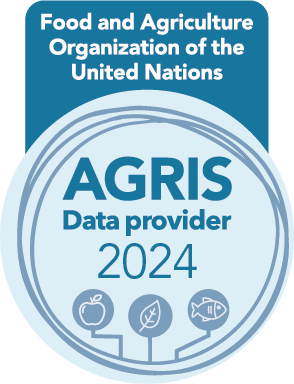Unveiling the secret pollinators: A deep dive into moringas' pollination ecology
DOI:
https://doi.org/10.14719/pst.6655Keywords:
Apis cerana indica, Apis pollinators, moringa, pollinationAbstract
A famous vegetable crop in India that is rich in nutrients and heavily dependent on bees for pollination is moringa. A survey was taken in the Karur and Perambalur districts of Tamil Nadu to document the diversity of pollinators and insect visitors of moringa. The observations were analyzed using diversity indices. According to the studies, 13 hymenopteran, 7 dipteran, and 7 lepidopteran insects visited moringa plants. Fruit set and quality are maximized in moringa when pollination is successful. Therefore, four treatments have been applied to the Asiatic hive bee, Apis cerana indica, to explore the pollination capability and the foraging ecology of other key bee pollinators of moringa. The results affirmed that the significant Apis pollinators spend more time on nectar collection than pollen gathering. The peak foraging activity of Apis pollinators happened in the morning hours during 0900 -1100h. A. cerana indica and A. dorsata commence their foraging activity much earlier in the morning than A. florea. The foraging activity gradually declined after 1400h. The abundance of A. cerana indica was very high in managed bee pollination plots compared to open pollination plots. The managed bee pollination plots (128.2 fruits/tree) recorded 19.14 percent more fruit sets and 11.40 % more fruit yield than open pollination plots (107.6 fruits/tree) by deploying four Asian bee colonies per acre of moringa crop.
Downloads
References
Srivastava S, Vinay KP, Kshirod KD, Dayal D, Wal P, Debnath B, et al. Dynamic bioactive properties of nutritional superfood Moringa oleifera: A comprehensive review. J Agric Food Res. 2023;14. https://doi.org/10.1016/j.jafr.2023.100860
Moringa market size, share, growth, forecast 2030.ZMR 7591[Internet]. 2023 [Cited 2023 Sept 9]. Available from: https://www.zionmarketresearch.com/report/moringa-market
Anwar F, Latif S, Ashraf M, Gilani AH. Moringa oleifera: A food plant with multiple medicinal uses. Phytother Res. 2007;21:17–25. https://doi.org/10.1002/ptr.2023
Jyothi PV, Atluri JB, Reddi SC. Pollination ecology of Moringa oleifera. Proceed Ind Acad Sci. 1990;100(1):33–42. https://doi.org/10.1007/BF03053466
Bhattacharya A, Mandal S. Pollination, pollen germination and stigma receptivity in Moringa oleifera Lamk. Grana. 2004;43:48–56. https://doi.org/10.1080/00173134.2004.11877463
Deodikar G, Suryanarayana M. Pollination in the service of increasing farm production in India. Adv Pollen Spore Res. 1977;2:67–87.
Klein AM, Bernard EV, Cane JH, Dewenter IS, Cunningham S, Tscharntk CKT. Importance of pollinators in changing landscapes for world crops. Proc R Soc B. 2007;274:303–13. https://doi.org/10.1098/rspb.2006.3721
Somiya C, Srinivasan MR, Saravanan PA. Diversity of pollinators in Drumstick, Moringa oleifera Lam. ecosystem. Mad Agric J. 2018;105(4-6):186–90. https://doi.org/10.29321/MAJ.2018.000127
Bhatnagar S, Rathore LS, Ameen UK, Geeta V, Sharma N, Kumar B. Record of insect pollinators of Moringa oelifera Lam. J Entomol Zool Stud. 2018;6(4):389–91.
Suneetha T, Raju AS. Foraging activity of carpenter bees in relation to floral biology of the drumstick tree, Moringa oleifera Lamk. (Moringaceae). J Palynol. 2019;55:99–108.
Sharma D. Moringa oleifera Lam.: The honey bee heaven plant in Jammu and Kashmir. Bee World. 2019;96:120?22. https://doi.org/10.1080/0005772X.2019.1638688
Shannon C, Weaver W. The mathematical theory of communication. Illinois (US): University of Illinois Press; 1963.
Chukunda FA. Abundance and diversity of insect visitors to flower of moringa oleifera at forestry and environment arboretum. Res J Forest. 2016;3(2):1–15.
Palanichamy P, Baskaran S, Mohandoss A. Insect pollination of the moringa plant Moringa concanensis nimmo Linn. Environ Ecol. 1995;13(1):47–51.
Krieg J, Goetze D, Porembski S, Arnold P, Linsenmair K, Stein K. Floral and reproductive biology of Moringa oleifera (Moringaceae) in Burkina Faso, West Africa. Acta Hortic. 2017;1158:63–70. https://doi.org/10.17660/ActaHortic.2017.1158.8
Price R, Grüter C. Why, when and where did honey bee dance communication evolve?. Front Ecol Evol. 2015;3:125. https://doi.org/10.3389/fevo.2015.00125
Narmadha KM, Saravanan PA, Umapathy G, Velmurugan M. Foraging activity of managed bee pollinator (Apis cerana indica) in bitter gourd cropping system in India. Ulud Bee J. 2021;21(2):216–26. https://doi.org/10.31467/uluaricilik.1000935
Somiya C, Srinivasan MR, Saravanan PA. Influence of Indian honey bees and other pollinators on the yield improvement of moringa. Mads Agric J. 2023;110(4-6):1–11. https://doi.org/10.29321/MAJ.10.200814
Pushpalatha S, Hariprasad Y. Foraging behavior of Indian honey bee in bee pasturaging plants at Annamalainagar ecosystem. Int J Recent Sci Res. 2015;6(10):6974–76.

Downloads
Published
Versions
- 07-03-2025 (2)
- 04-02-2025 (1)
How to Cite
Issue
Section
License
Copyright (c) 2025 P A Saravanan , V Ravichandran , P Veeramani , M Velmurugan, J Jayakumar, M Alagar

This work is licensed under a Creative Commons Attribution 4.0 International License.
Copyright and Licence details of published articles
Authors who publish with this journal agree to the following terms:
- Authors retain copyright and grant the journal right of first publication with the work simultaneously licensed under a Creative Commons Attribution License that allows others to share the work with an acknowledgement of the work's authorship and initial publication in this journal.
- Authors are able to enter into separate, additional contractual arrangements for the non-exclusive distribution of the journal's published version of the work (e.g., post it to an institutional repository or publish it in a book), with an acknowledgement of its initial publication in this journal.
Open Access Policy
Plant Science Today is an open access journal. There is no registration required to read any article. All published articles are distributed under the terms of the Creative Commons Attribution License (CC Attribution 4.0), which permits unrestricted use, distribution, and reproduction in any medium, provided the original author and source are credited (https://creativecommons.org/licenses/by/4.0/). Authors are permitted and encouraged to post their work online (e.g., in institutional repositories or on their website) prior to and during the submission process, as it can lead to productive exchanges, as well as earlier and greater citation of published work (See The Effect of Open Access).









